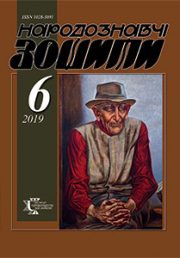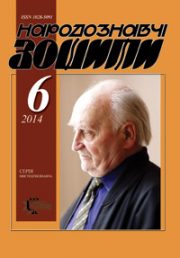The Ethnology Notebooks. 2025. № 5 (185), 1078—1084
UDK316.334.5(477.83/.86)
RURAL AND URBAN SPACES IN 1920s—1930s GALICIA THROUGH THE EYES OF REPRESENTATIVES OF THE WOMEN’S MOVEMENT
VOITOVYCH Nadiia
- ORCID ID: https://orcid.org/0000-0001-6313-9585
- PhD (History), Associate Professor,
- Stepan Gzhytskyi National University
- of Veterinary Medicine and Biotechnologies in Lviv,
- Department of History of Ukraine and Economic Theory,
- 50, Pekarska St., 79010, Lviv, Ukraine,
- Contacts: e-mail: wojtovych@ukr.net
Abstract. Ukrainian society in Galicia during the interwar period was heterogeneous, shaped by the assimilation policies of the Second Polish Republic and direct coexistence with both Poles and Jews. The society existed in two distinct spaces: the urban environment (dominated by Poles) and the rural one (where Ukrainians prevailed). The village preserved Ukrainian traditions but lagged behind in terms of organizational and socio-economic development. The city, while largely assimilated by Poles, offered significantly more opportunities for cultural and social engagement. Periodical publications — particularly women’s journals such as «Nova Khata» («New Home») and «Zhinocha Dolia» («Women’s Fate») — are of considerable importance, as they shed light on various aspects of the women’s movement in Galicia. The aim of this article is to illustrate how representatives of the women’s movement in Galicia viewed rural and urban daily life; to highlight how their public activism helped to reduce the disparities between these two environments; and to provide examples of how urban intellectuals engaged with rural culture and, conversely, how peasant women came to «discover» and engage with urban life. The object of this study is the women’s movement in interwar Galicia, while the subject is the perception of daily rural and urban life by its representatives and their public activity aimed at overcoming the civilizational and everyday differences between village and city. Chronologically, the study covers the 1920s—1930s. Geographically, it focuses on the regions of Ukraine that were part of the Second Polish Republic during the interwar period — namely, the modern-day Ivano-Frankivsk, Lviv, and Ternopil regions. The research methodology is grounded in the principle of historicism and employs both general scientific and specialized historical methods, particularly comparative-historical analysis. Special emphasis is placed on a careful examination of women’s press from the 1920s—1930s. The study reveals how representatives of the women’s movement reflected on the everyday realities of city and village life. It demonstrates that these women overcame numerous challenges — ranging from societal conservatism and patriarchal structures of the Galician society to both internal and external forms of misogyny. The research shows that, through cooperation with peasant women, the leaders of the women’s movement succeeded in bridging the civilizational divide and aligning the daily experiences of urban and rural women. They achieved this through various forms of communication and engagement, physical presence in each other’s worlds — illustrated, for example, by the cases of a gardener and a housemaid.
Keywords: Galicia, women’s movement, village, city, everyday life.
Received 30.08.2025
REFERENCES
- Bohachevska-Khomiak, M. (1995). White on white: women in the public life of Ukraine. 1884—1939. Kyiv: Lybid [in Ukrainian].
- Malanchuk-Rybak, O. (2006). Ideology and social practice of the women’s movement in the western Ukrainian lands of the XIXth — first third XXth centuries: typology and European cultural and historical context. Chernivtsi: Knyhy XXI [in Ukrainian].
- Diadiuk, M. (2011). Ukrainian women’s movement in the interwar Galicia: between gender identity and national engagement. Lviv: Astroliabiia [in Ukrainian].
- Kis, O. (2012). A woman in the traditional Ukrainian culture (second half of the XIXth — early XXth centuries). Lviv: Instytut narodoznavstva NAN Ukrainy [in Ukrainian].
- Holyk, R. (2014). Between emancipation and folk tradition: woman, stereotypes and everyday life in Lviv periodicals of the 20s—30s of the twentieth century. The Ethnology notebooks, 1 (115), 29—37 [in Ukrainian].
- Y., R. (1937). It is really time to save our clergy. Nyva, 6, 203—212 [in Ukrainian].
- Blazhkevycheva, I. (1929). How to do work in the countryside. Nova khata, 8—9, 8—10 [in Ukrainian].
- Baranova, B. (1926). Go to the village! Zhinocha dolia, 2, 2—3 [in Ukrainian].
- (1925). From the woman’s movement. Nova khata, 3, 14 [in Ukrainian].
- Blazhkevych, I. (1938). A woman-citizen in the family. Nova khata, 15—16, 7 [in Ukrainian].
- Lysohirska, Zh. (1937). Concessions that demote us. Zhinocha Volia, 12, 6—7 [in Ukrainian].
- Dychkovska, A. (1929). To the article «A few words to entertain our women». Zhinocha dolia, 6, 4 [in Ukrainian].
- Hanusyn, O., & Kis’, O. (Ed.). (2023). «Not only unconscious, but also evil, evil as snakes»: internal misogyny among the Ukrainian women of Galicia at the turn of the XIXth and XXth centuries. Zhinochi vymiry mynuloho: uiavlennia, dosvidy, reprezentatsii: monohrafiia (Pp. 234—248). Lviv: Tsentr miskoi istorii; IN NAN Ukrainy [in Ukrainian].
- Hook, I. (1929). A few words to entertain our women. Zhinocha dolia, 1—2, 7—8 [in Ukrainian].
- (1935). A word in the case of our bourgeoisie. Zhinocha dolia, 10, 6 [in Ukrainian].
- E., K. (1937). Kindergartens. Nova khata, 1, 8—9 [in Ukrainian].
- Stefa, H. (1927). Bourgeois women! Zhinocha dolia, 19, 2—3 [in Ukrainian].
- Duchyminska, O. (1931). Let’s take a step forward. Zhinocha dolia, 46, 4 [in Ukrainian].
- Romaniuk, M. (1937). Come to your senses, be human… Zhinocha Volia, 11, 6—7 [in Ukrainian].
- Hotska, O. (1933). Hey, Cherche! Zhinocha dolia, 6, 4—6 [in Ukrainian].
- O., K. (1935). Let’s think for a minute during the holiday hour. Zhinocha dolia, 8—9, 2—4 [in Ukrainian].
- Kysilevska, O. (1926). Good news. Zhinocha dolia, 4, 2 [in Ukrainian].
- Lemekha-Lutska, O. (1985). In the prisons of the three occupiers. Almanakh Stanyslavivskoi zemli. Zbirnyk materiialiv do istorii Stanyslavova i Stanyslavivshchyny, 2, 349—364 [in Ukrainian].
- Melia. (1928). The revolution. Nova khata, 1, 6—7 [in Uk rainian].
- Burachynska, L. (1936). More about a woman’s right to work. Nova khata, 11—12, 6 [in Ukrainian].
- «Eva». (1932). Spousal support! Nova khata, 11, 13 [in Ukrai nian].
- Mandiukova, Ya. (1937). Woman’s page. The joy of life. Dilo, 66, 5 [in Ukrainian].
- Khaburskyi, S. (1933). Kindergartens and us. Nyva, 5, 182—185 [in Ukrainian].
- Khaburskyi, S. (1933). Kindergartens and us. Nyva, 4, 138—142 [in Ukrainian].
- Pasternakova, M. (1936). Foreign and our preschool education. Nova khata, 15—16, 15—16 [in Ukrainian].
- L. (1934). Kindergartens. Nova khata, 10, 12 [in Ukrai nian].
- Duchyminska, O. (1937). A big celebration of Ukrainian women workers in Lviv. Zhinocha dolia, 23, 15—16 [in Ukrainian].
- Nyzhankivska, M. (1939). A servant girl from the Ukrainian village. Nova khata, 4, 4 [in Ukrainian].
- Shyian, O. (2024). The sin of debauchery and tireless labor: what life was like for servant girls in Lviv. Family stories of the early XXth century. Retrieved from: https://zaxid.net/yakim_bulo_zhittya_sluzhnits_u_lvovi_na_pochatku_xx_stolittya_istoriya_simyi_n1589686 (Last accessed: 19.09.2025) [in Ukrainian].
- Cherchovych, I., & Kis’, O. (Ed.). (2023). The poor and pregnant women in Lviv in the late of XIXth century. Zhinochi vymiry mynuloho: uiavlennia, dosvidy, reprezentatsii: monohrafiia (Pp. 373—388). Lviv: Tsentr miskoi istorii; IN NAN Ukrainy [in Ukrainian].






